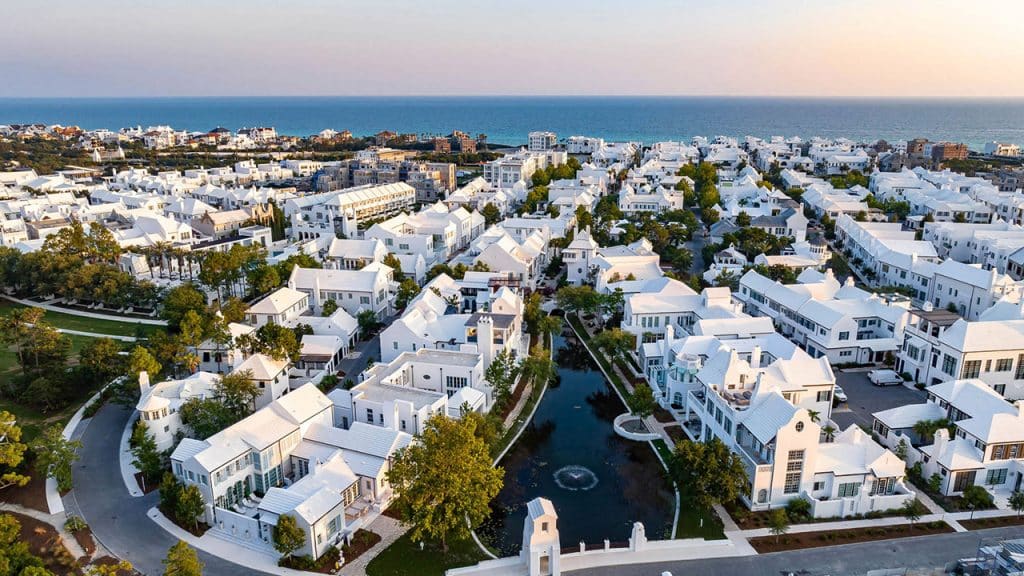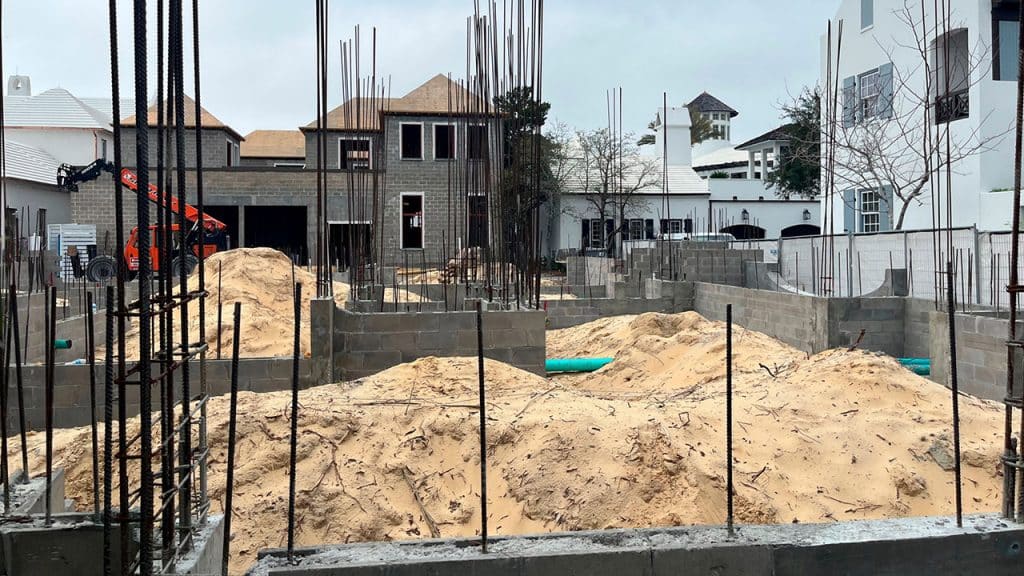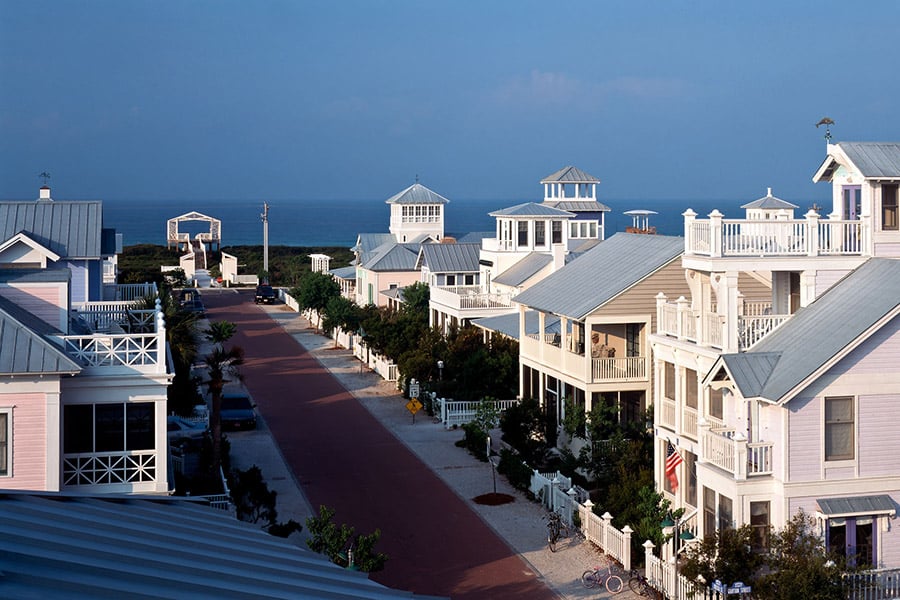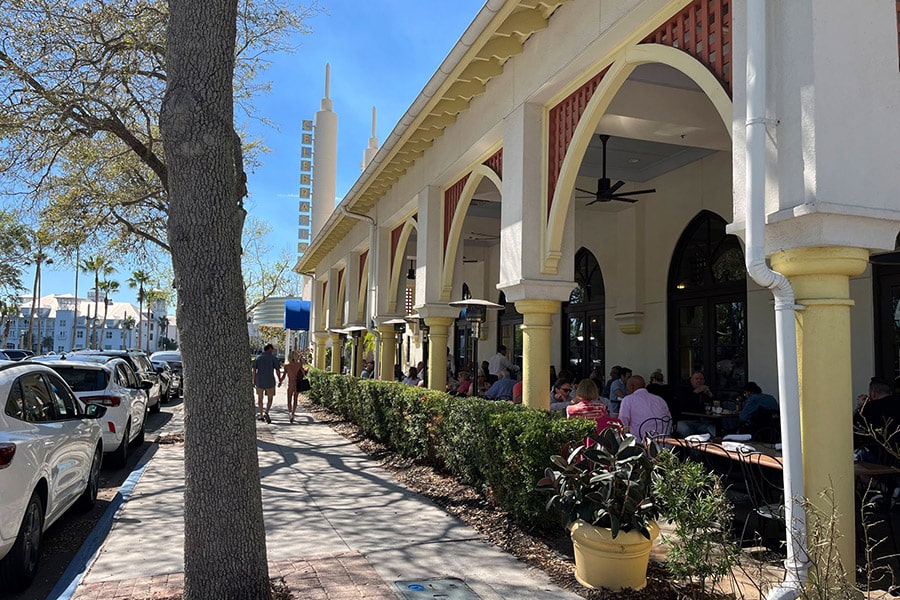
Returns to new urbanism
It has been roughly 40 years since new urbanism arrived on the American real estate development scene. Beginning in the early 1980s with the new town of Seaside, Florida, the movement that pioneered a thoughtful and somewhat radical response to the urban sprawl following World War II, has “grown up.” Certainly, Seaside, Rosemary Beach and Alys Beach have represented some of the most successful real estate developments in Florida, if not the United States.
Beyond the resort-oriented developments along the Florida coast, other notable developments such as Celebration, a suburb of Orlando, and the Baldwin Park neighborhood in Orlando have offered a very different view of the movement through the years. I’on in Charleston, S.C., and Seabrook, Wash., as well as hundreds of other communities, both in the U.S. and internationally, have proven the staying power of the core principles of the movement.
In fact, many elements of traditional neighborhood developments (TNDs), as these types of new communities became known, are being adopted throughout mainstream real estate development. New urbanist tenets such as walkability, mixed-use, diversity of housing types and smart transportation concepts have been adopted both by private developers, as well as many forward-thinking municipalities. What once was a core set of principles, adopted by developers, as somewhat of a “package,” has become a wide range of features often chosen a la cart. In this way these ideas have become characteristics of communities, implemented on a varied basis.
It is easy to conclude that developers see value in using these concepts in the projects they build. After all, if there weren’t value, the movement and its principles would have fallen by the wayside, relegated to the infinitely wide-ranging list of failed real estate ideas. Instead, today we see the principles and concepts associated with new urbanism nearly everywhere. From full fledge TNDs and transit-oriented projects, to minute details seemingly subtly embedded in planned unit developments across America. It is difficult to find a new development today that, at least in part, doesn’t reflect some of the movement’s design features.
Premiums
If new urbanist ideas have value, the question quickly becomes: How much value do they add to a development? One way to approach this question is to look at price premiums associated with these types of properties. A number of studies have examined the question of whether new urbanist principles add a “premium” to the value of the houses built.
Early surveys on TNDs indicated that buyers regard new urbanist features as desirable and may be willing to pay a higher price for properties in a TND. More detailed research of actual transactions has also been conducted. One such study is “Valuing the New Urbanism: The Case of Kentlands,” conducted by Charles C. Tu and Mark Eppli. The study involved over 2,000 home transactions in Kentlands, located in Gaithersburg, Md. With 714 single-family houses, the neighborhood was one of the earliest TNDs.
TND planning has evolved to be more curvilinear to follow wetland, topographic or other natural environmental features rather than a more typical grid found in earlier iterations. We have utilized alleys, mews and prioritized pedestrian traffic with trail systems to encourage walkability and the use of common amenities such as pocket parks. We evaluate the ability to increase density, housing product differentiation and preserve streetscapes with the burden of greater infrastructure costs and increased coordination among stakeholders.
— Interview with Jeff Reader of Reader Communities, developer of Holding Village in Wake Forest, N.C., and Rivington in DeBary, Fla.
While much of the research on new urbanism has focused on descriptive comparisons or design aspects of TNDs, this study empirically measures the impact that new urbanism has on single-family house prices. The authors assess the traditional neighborhood development from the housing market perspective and estimate the price differential between houses in a TND and those in conventional subdivisions. They concluded that homebuyers are willing to pay a premium of 12%, or approximately $25,000, to purchase a home in Kentlands. The research accounted for differences in housing characteristics, such as age and quality of construction, as well as individual home features. The findings revealed that the price premium was attributable to the new urbanist features of the community, such as walkability, mixed use and traditional neighborhood design, rather than differences in home size, age or quality.
A third study of the possible premium of new urbanist development design was conducted on Orenco Station, in Hillsboro, Ore. The authors, Yan Song and Gerrit Knap, sought to identify how specific characteristics of new urbanist and conventional development affect values. They concluded that premiums for houses in these types of neighborhoods are attributable to an increase in the number of streets typically found in TNDs, smaller blocks, street network connectivity, better pedestrian accessibility to commercial uses, mixed uses and proximity to light-rail stations. Similar to the previous studies, the research concluded that the value of these features resulted in a price premium of more than $24,000 per house.
Costs
While the extent of research on the topic of new urbanist property values is relatively small, based on the studies that have been conducted there appears to be evidence that new urbanist principles increase property values. Property premiums, however, are only half of the analysis. Real estate developers are paid to bring capital to bear in the creation of the built space. There are costs to the endeavor. In addition, there is risk associated with development. Are the costs and risks associated with new urbanist projects different from conventional real estate developments?
I believe when developed in the appropriate locations, TND communities command a value premium and increase the diversity of housing alternatives above conventional subdivisions which typically offer more homogenously sized single-family homes. Increased costs can exist through the addition of rear alleys though efficient design can mitigate this factor. Architectural standards tend to be higher due to the need to finish two to three sides of the home. With more density, homes are increasingly multi-story which also adds cost and reduces some flexibility in floor plan design. [However], positive externalities exist for commercial, multifamily and retail uses.
—Jeff Reader
In examining the expenses associated with new urbanist projects, it is easy to conclude that they are elevated compared to conventional development. Increased density and mixed-use development increase complexity. In addition, these types of projects often incorporate unique architectural, design and infrastructure costs. From soft costs to materials and labor, new urbanist projects are thought to be more expensive to design and implement for the developer. For example, many TNDs often incorporate more streets into the neighborhood and use alleys behind the homes to remove as much traffic as possible from the street. The additional design work, pavement and other elements of the streets and alleyways adds costs to the overall project.
What about risk? Are new urbanist projects more risky than conventional developments? When the concept was new and untested, it certainly seemed so. Even today, new urbanist projects bring to market a relatively unique, costly product, sometimes marketing to a select group of customers. This adds market risk. Additionally, increased government and approval scrutiny, higher complexity in design, as well as the execution of higher density and mixed uses adds risk to a project. Based on these risk factors, new urbanist-related projects also tend to find it more difficult to get financing, resulting in higher financing costs to raising capital.

With multiple uses and property types often incorporated into a single project, many lenders pro forma each separately to access cash flows and risk (Gyourko 2001). Since lenders frequently tend to lend in only one or two property types, developers often find that they are forced to finance their projects with multiple lenders, each with different approaches to underwriting. These complications, and the multiple legal and practical approaches to financing, on both the debt and equity sides, increases the difficulty and risk associated with the project.

Adding complication is that many new urbanist developments often require an extensive amount of time in the approval process and then have a relatively long build-out time frame when compared to conventional developments. Although George de Guardiola, the developer of Abacoa in Jupiter, Florida considers the project a “great success,” it would have been more successful if the permitting and financing processes had been faster, de Guardiola told Public Square, a journal from the Congress for the New Urbanism in 2001. “Nothing influences real estate more than time use of money. If we took one year [to obtain permits] instead of two, this would have been widely successful rather than just successful.” Abacoa had, at that time, an internal rate of return (IRR) in the “high teens.” With faster approval, that IRR would be in the “low 20s — at that level it would be a very attractive project to the lenders and institutional investors that do not normally look at such a project.”
Returns
Clearly there are additional costs and risks associated with new urbanist development. The research on this topic has provided evidence that, to compensate for these added costs, these types of products command a higher return. To determine whether the premiums justify the additional costs and risk, an analysis of property transaction prices, costs and risk is necessary. While data related to the transaction prices of properties is readily available, cost data is not. Private developers do not make their expenses public. Therefore, examination of returns is difficult.


Some research has been conducted related to returns associated with TNDs. “Financing New Urbanism Projects: Obstacles and Solutions,” a survey-based study by Joseph Gyourko and Witold Rybezynski concluded that new urbanist development is riskier and commands a higher return. The authors surveyed 55 professionals in the field to gauge perceptions of risks in new urbanist development. The results indicated that developers, lenders and equity investors expected higher returns related to these types of projects to compensate for higher risks. How much higher? It is unclear.
The authors state in the study that “there was no financier, whether on the debt or equity side, who thought these projects on average should have a required rate of return of less than 15 percent.” This benchmark, however, without context does not provide a basis for assessing returns associated with real estate development.
There has been little empirical research to analyze actual returns to developers of these types of projects, based on project data. In addition, given the regulatory hurdles, prolonged build-out time frames and other complexities of multiple uses and product types, it can be difficult to apply conventional benchmarks to the metrics associated with new urbanist development.
Public benefits
As a part of the analysis of developer returns, it may also be necessary to address the issue of whether new urbanism creates public value. In addition to the benefits to society of walkability and intentional transportation solutions, among others, it is often argued that the public spaces created in TNDs result in value being created for the community as a whole. The theory is that this value benefits the citizens of the surrounding areas and visitors in addition to those that live in the TND.
Many public-private new urbanist projects benefit the residents of the overall community. These types of projects often pool resources and expertise, result in faster project delivery, foster innovation and result in community-focused developments. Some new urbanist projects are explicitly conceived as legacy projects, designed to create enduring, positive change in communities. These legacy projects, often in conjunction with the local municipality, provide pro bono technical assistance to communities in underserved areas to implement sustainable urban design solutions that will benefit future generations. Examples include the Providence Hospital District Vision Plan in Rhode Island, which aims for long-term redevelopment and health benefits and the Louisville Creek Restoration in Kentucky, which focuses on green infrastructure and neighborhood connectivity.
The economics of these types of public-private partnerships, however, are often skewed when compared to traditional private development. The land cost or financing of the project, among other factors, can be influenced by the municipality’s involvement in the project. Therefore, drawing any conclusions related to returns from these partnerships does not provide an indication of returns that can be applied to private development in general.
Even in a strictly private development, the benefits of new urbanism provide social value to the community. By prioritizing pedestrian-friendly design and mixed-use development, new urbanism fosters vibrant communities where people can easily access daily needs, interact with neighbors and enjoy a strong sense of place. These environments encourage social engagement, reduce car dependency and support more active lifestyles, all of which contribute to improved well-being for residents. Perhaps private developers value their contribution to the community wellbeing as a supplement to the financial returns.
Additionally, a key aspect of new urbanism’s public good is its positive impact on environmental sustainability and economic vitality. Studies have shown that compact, mixed-use neighborhoods help reduce urban sprawl, preserve natural resources and lower greenhouse gas emissions by minimizing reliance on automobiles and promoting alternative transportation options like walking, biking and public transit. At the same time, these communities support local businesses, increase property values and create diverse housing opportunities, making neighborhoods more inclusive and financially resilient.
New urbanist projects also often create public spaces that serve as the backbone of community life and foster a sense of belonging among residents. Well-designed parks, plazas and town centers provide venues for social interaction, cultural activities and recreation, enhancing the overall quality of life. By integrating sustainability, accessibility and community engagement into urban design, new urbanism creates places that can deliver lasting public good for individuals and society as a whole.
It isn’t difficult to conclude that public good can come from private development in this context. Is this something, however, that should be considered when assessing the returns generated to the developer and other economic stakeholders, who bear the cost and risk of the endeavor alone? On a project-by-project basis, it is difficult to imagine that most developers, investors or lenders directly consider the public benefit in assessing the private economic merits of a project.
As de Guardiola explained, the goal of the development industry is “to make as much money as they can, as fast as they can. The majority of developers I know love the new urbanism concept. The questions I’m always asked are how much money does it make and how fast.” Much research is needed to answer this question.
Steve Martin, Ph.D., is a clinical assistant professor of real estate at the University of Florida’s Warrington College of Business.
Related Stories
Sign up for our mailing list
For the media
Looking for an expert or have an inquiry?
Submit your news
Contact us
Follow us on social
@ufwarrington | #BusinessGators


